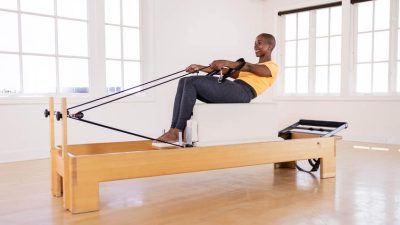
By: Claire Sparrow
At least 50% of women pre-menopause experience symptoms of prolapse, and up to 85% of women post-menopause experience prolapse. I wanted to share these statistics right off the bat because, as Pilates teachers, we are often working with women who may or may not know or disclose that they have prolapse. Many women will not see their class or private session with you as relevant to their prolapse or realize that what you do together could help or hinder their symptoms. Additionally, women may not know the symptoms to look out for.
I know this might feel worrying or surprising and you may not currently have the tools you need to start a conversation and support women with prolapse.
What is prolapse?
Prolapse is often defined as a dropped or fallen organ due to the weakness of the pelvic floor muscles. I would suggest that this is not entirely true because we know based on the principles of biotensegrity that we are a suspension system where tension is what supports us. What that really means is that it is not strength alone that supports our organs, it’s the balance of tension, for example not too much strength and not too much laxity. Balance.
With this understanding I redefined prolapse in my bestselling book, HOPE For Your Pelvic Floor:
“Pelvic Organ Prolapse is the displacement of one or more pelvic organs, such as the uterus, bladder or bowel due to an imbalance of the tensional support in or influencing the pelvis.”
I also suggest a new name for it, Pelvic Organ Displacement (POD). (Sparrow. C. HOPE For Your Pelvic Floor. Pp53)
What are common causes of prolapse?
That balance is what leads us to what can go wrong and cause an organ to displace. One of the most common causes of imbalance is scar tissue from a birth injury. 95% of women who have a vaginal delivery will experience some degree of injury from a graze to a tear or episiotomy. If in your screening a woman tells you that she had a normal birth, it is worth asking if she had any intervention because if she had an assisted delivery she would have had an episiotomy. It’s important to note that scar tissue is essential to bring the tissue together and promote healing, however, it is like an iceberg where the surface scar is the tip, and it spreads far and wide and can pull a pelvic organ out of place. This has been proven by my colleague Anna Crowle and you can find her work here.
What are the symptoms women may report?
You may be surprised to know that incontinence is not a common symptom of prolapse because the displaced organ prevents this. The main symptoms women experience is heaviness, tissue that feels out of place like a tampon is stuck and low back or sacrum pain.
The three most common types of prolapse are:
- Cystocele: the bladder displaces/bulges into the vagina and can create pressure into the lower abdomen.
- Rectocele: the rectum displaces/bulges into the vagina and can feel like they haven’t fully emptied their bowels.
- Uterine: prolapse, the uterus displaces/bulges into the vagina can often feel like they have a tampon or toilet tissue stuck or their internal folds of skin are in the wrong place.
What can you do?
Now that you have a basic understanding of prolapse and appreciate how many women you teach may in fact be experiencing prolapse, how can you support them? I have created a basic three-step process to help you have a way to support those women.
- Step One: Add the question to your intake form.
- Adding these questions will open up the conversation and give you the information you need to plan appropriately for your client. Do you have pelvic organ prolapse? Do you suspect you may have pelvic organ prolapse?
- Step Two: Address and assess their breath.
- Due to the fear and worry women carry around their organs falling out they will often go into a gripping and holding pattern that inhibits their diaphragmatic breathing process. This is something you can assess with them seated or standing to find out if they are allowing their breath to move into their pelvis. If not, you have the tools to create a positive movement experience that allows breath into the pelvis.
- Step Three: Stimulate their pelvic floor through movement.
- Instead of the traditional route of recruiting consciously, use your exercise choice, cues and intelligent imagery to help them access their spontaneous dynamic pelvic floor muscle recruitment. This might mean doing more exercises in quadruped, seated and standing where you are activating the diaphragmatic system or challenging it.
- Some of my favorites are double leg pump on the chair seated on the Oov, hamstring one kneeling cat variation, squats from the push through bar standing on the Oov and introducing pulses. There are so many to choose from.
Considerations
These three steps are a great start and even if you didn’t do these things, you may just need to know if there is anything to avoid, go with caution or be aware of:
- If they have pressure in their lower abdomen, it may feel uncomfortable to lie prone.
- They may feel embarrassed doing rolling or inversion exercises where they may pass gas due to lack of control.
- For some women, loaded adduction like horseback may be uncomfortable or increase their symptoms.
I hope that you find this an eye-opening starting point and if you would like to find out more or join me in my membership or mentorship you can reach out to me or find out more at my website.
If you would like to learn more during the month of June, you can join me FREE every Wednesday at 8pm BST for Prolapse Awareness month.
About the Author:
Claire Sparrow is the Author of the bestselling book HOPE For Your Pelvic Floor, a Podcaster, Educator, Second Generation Teacher, & Pilates Studio Owner with over 20 years of experience.
Claire founded her Whole Body Pelvic Health Method in 2018 after restoring her own prolapse and has helped thousands of women worldwide to restore their pelvic health so that they can step off the sidelines, into the spotlight and achieve their dreams. She has reinvented pelvic floor exercises, presents internationally and has mentored teachers in her method. Claire has created two pelvic health series’ for Pilates Anytime US, has been featured in Refinery 29, Natural Way, and Stylist Magazine and is the go-to recommendation for many leading women’s health physiotherapists.
Claire is a Scotswoman, a mum of 3 and lives in Leeds. Her positive and humorous approach is refreshing, inspiring and fueled by empathy.
She is the voice of HOPE.
You can follow Claire on Instagram and Facebook.
Related







